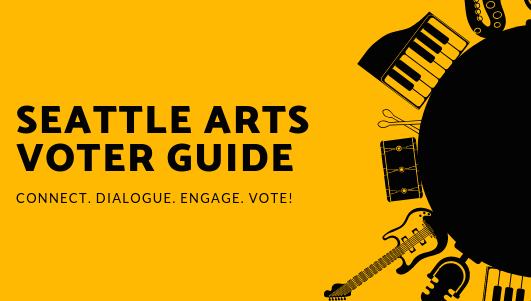Candidate: Jeremy Cook, Candidate for District 6
- Website: https://www.cookforcouncil.com/
ARTS PLATFORM
Seattle Arts Voter Guide: Describe a meaningful arts experience that has stayed with you over time.
Cook: It was the first day of eighth-grade art class, our teacher Mr. Plourde had assigned us any easy drawing project. As he was going around the room helping students and asking how their summer was. When he came to our table and asked how our summer was, one of my table mates Stacy had something on her mind.
She quickly replied. “it went ok except for this last weekend. Looking a bit sad and distraught.”
Mr. Plourde asked, “Why what happened?”
Stacy said “Well, Bob Ross was going to be on TV. So, I got my paints and everything ready to go, that way I could paint along with him.”
Mr. Plourde said “that’s great! How did it go?”
Stacy said “Well… My painting didn’t turn out anywhere near as good as his did.”
Mr. Plourde didn’t miss a beat, he brilliantly responded: “That’s ok Stacy, He might have a little bit more practice than you do.”
We all got a laugh out of the obviousness.
I remember that class, and that teacher as if it was yesterday. It was a great semester. I have been truly blessed to have had so many great art teachers in my lifetime.

SAVG: How do the arts reflect the voices and perspectives in your own neighborhood?
Cook: There are all sorts of great artists throughout Ballard (my neighborhood) as well as the rest of the sixth district which includes Fremont, Green Lake, Greenwood and more.
Many restaurants and coffee shops are good about showcasing local artists work sometimes it is just for display, but oftentimes their work is often for sale. One of my favorite restaurants that does this often is Gorditos. They also serve a burrito that’s the size of a baby which is a work of culinary art in itself.
Another great place to visit is the Nordic Museum, They also showcase many different kinds of local art and there regular display is a great way to learn about the Nordic history in the Ballard area.
Also, many of the local bars showcase local musical artists. One that has great performance places is The Tractor Tavern featuring a wide range of Artists. I feel this area is very creative and positive towards the arts.
SAVG: As a graphic designer, aesthetic design is critical in your field. I am curious about your opinion regarding the fundamental importance of art for Seattle. Do you have plans to elevate the arts if you became a council member?
Cook: Since 1973 one percent of Seattle’s capital improvement funds have gone towards the commission, purchase, and installation of art. This has resulted in a vast art collection. Which is great!
One problem, however, is that in many cases the installation part is overlooked. This has resulted in large amounts of art that may never be seen by the taxpayers that have paid for the work. It is stored away. I would like for people to be able to see and appreciate the art that they have purchased.
This could be accomplished a couple of different ways. One way could be a library checkout system for businesses open to the general public.
Another way may be to use some of the same art funding to pay for temporary art installation displays (aka public art galleries) throughout the city.
SAVG: What role do you believe arts and culture has in the changing landscape of Seattle’s population?
Cook: I believe the arts are crucial in making the city’s population more creative, innovative and better educated. Art by its very nature gives people perspective and insight into the people that create it.
I think Myth Buster’s Adam Savage said it well with his quote “If you want the kids’ test scores up, bring back band and bring back shop and get kids actually learning stuff instead of teaching them how to take a test.”
I feel, that an education that includes teaching people how to create, also helps them problem solve in other areas of their lives.
SAVG: What would you do if cultural center stood in the way of a housing development?
Cook: I would hope that this would never happen. Of course, it would need to be based on a case by case basis.
I wouldn’t think that a cultural center would sell to a developer. If a cultural center were in trouble financially I would think that some of the one percent for arts funding could be used as a partnership to showcase cultural art as well as host events.
